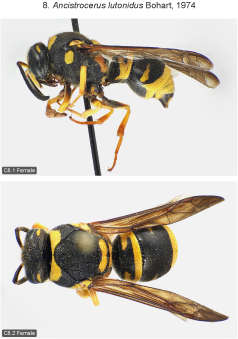
| Home | Table of contents | Keys | Species list | Glossary | Image data | PDF | Cite this article | Feedback | Updates |
Identification Atlas of the Vespidae (Hymenoptera, Aculeata) of the northeastern Nearctic region
CJAI 05, February 19, 2008
doi: 10.3752/cjai.2008.05
Matthias Buck, Stephen A. Marshall, and David K.B. Cheung
Department of Environmental Biology, University of Guelph, Guelph, Ontario, Canada N1G 2W1
Next species | Previous species | Key
8. Ancistrocerus lutonidus Bohart, 1974
Figs B3.7, 41; C8.1–4.

|

|
Species recognition. Similar to A. catskill but with more extensive yellow markings and body larger in size. The female is unique within the genus in having all of sternum 2 behind the basal groove covered in short, appressed pubescence (absent medially on a larger or smaller patch in other species) and in possessing an evenly and fairly densely haired penultimate segment of the labial palpus (this segment almost bare or with scattered hairs in other species). Furthermore, the cephalic foveae of the female are paired with a distinct horizontal area between them (coalescent in A. catskill or, at most, divided by a narrow septum). The male is distinguished from all other species in possessing discal spots on tergum 2 (rarely the spots absent). Besides characters provided in the key the male differs from A. catskill by the slightly longer flagellomere XI, the more rounded pronotal angle (distinctly angulate in A. catskill) and the more extensive yellow markings on the hind femur (at least in some areas covering more than apical half; in A. catskill usually at most apical fourth yellow, rarely with a dull yellow streak extending to middle of femur).
Variation. Fore wing length 7.0–8.0 mm (♂♂), 9.0–10.5 mm (♀♀). Female clypeus entirely yellow, sometimes with a central black spot or a black stripe in basal half extending to dorsal margin of clypeus. Yellow spot of mandible sometimes absent in female. Parategula marked with yellow in female, usually black in male. Pair of yellow scutellar spots very narrowly separated, often fused in female, rarely in male. Propodeum in female with a pair of lateral elongate yellow spots from dorsum to ventral margin, interrupted at level of pronotal angle in some specimens. Metasomal terga 1–5 (female) or 1–6 (male) fasciate, tergum 6 of female almost always with a yellow preapical spot. Fascia of tergum 1 angulately produced forward and often also inward behind transverse suture. Discal spots of tergum 2 rarely connected to apical fascia, rarely missing. Sterna 1–5 (female) or 1–(5)6 (male) with entire apical fasciae. Sternum 2 of male sometimes with a pair of obscure, amber, discal spots.
Distribution. Not yet recorded from Canada but due to its occurrence in Buffalo, NY (Bequaert 1944a) it is to be expected in southern Ontario. Eastern U.S.: MA to SC, west to WI, IN and TX (Krombein 1979), also recorded from ME and GA by Bequaert (1944a).
Biology. The nest is attached to twigs of low bushes and consists of hardened clay with 6 to over 20 more or less radially arranged brood cells (Krombein 1979).
Next species | Previous species | Key
| Home | Table of contents | Keys | Species list | Glossary | Image data | PDF | Cite this article | Feedback | Updates |
